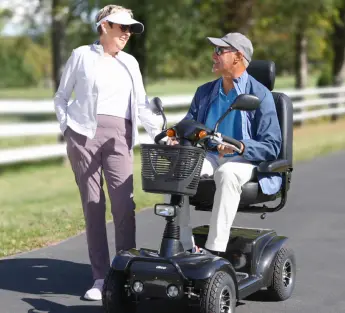Mobility Scooters at SpinLife
Who uses a scooter, and what distinguishes the different types and features.
A scooter can increase mobility for those who only need assistance occasionally, or who can use a manual chair most of the time. Scooters have the advantage of being motorized and can be less costly than the typical power chair. For those with good arm strength and upper body balance, a scooter might be a good solution.
A mobility scooter—usually three wheeled, but sometimes four—is often used by people who are able to walk to some degree, but are challenged by distances and slopes. Scooters are popular with elderly users, and people with progressive conditions such as Multiple Sclerosis, Muscular Dystrophy, or Arthritis when their walking is limited.
If you are unable to stand, a scooter may still have a role to play in your mobility.
"As a manual chair user, I own a scooter to climb some streets in my neighborhood in San Francisco. I also use it to go greater distances since I became concerned about the effect on my arms and shoulders from pushing a manual chair those distances. I find it useful for shopping, because rather than place merchandise in my lap while I wheel, I can carry it between my feet. You may also opt for a wire basket which hangs on the steering arm in front of you."
Given the fact that you steer a scooter—rather than control its direction with a joystick control—you need sufficient arm strength to drive one, as well as the use of your thumbs to press the controls.
Most mobility scooters are equipped with a "captain’s chair" which has vinyl- or cloth-covered foam upholstery. The cushioning is not designed for the kinds of advanced pressure relief that many people with disabilities require. If you have special cushioning needs, your choices will be narrowed to those scooters with adaptive seating options which accept specialized cushioning.
It is unusual for someone to spend the whole day in a scooter, the way full-time chair riders do with a wheelchair. Compared to a power wheelchair, a scooter is set apart by a variety of features:
- A driving arm – or "tiller" - centered in front of the body steers a single, front wheel. This arm can be tilted forward or back and locked at any desired position.
- Thumb levers are used to drive the scooter, usually pressing with the right thumb to go forward, the left to reverse.
- A seat mounted on a stem, capable of rotating to the sides, held in place by a lock/release mechanism.
- Rather than footrests, the scooter is designed with a base platform which carries the seat and batteries and supports your feet.
Scooters are usually equipped with automatic braking, so are not able to coast. You must apply the controls for all movement. A knob to set the maximum speed is usually included with the controls. Scooter controls are not as sophisticated as the new breed of power wheelchairs which include programming for acceleration and braking, among other advanced features. This means that, with a scooter, you must press and release the controls gently to modulate how quickly you start and slow down. Some scooter controls have a built-in delay to prevent sudden starts, but some users find it irritating to have to wait the extra moments to start each time they press the control.
The better scooter designs provide you with subtle controls that allow you to make small and slow movements. You need not fear that you will have trouble controlling a scooter if you have sufficient upper body control, however you must take care not to press a drive lever accidentally by catching your jacket on it, for instance. To prevent accidental movement, most scooters are key operated so that you can turn them off while you are at a standstill. A gear release will allow you to disengage the drive mechanism if the scooter needs to be pushed manually.
Since there is a steering arm in front of you, scooters don’t work very well at tables and desks. You can’t just wheel up to them, but instead have to pull alongside, rotate the seat, and then pull the table towards your body. Being turned to the side, there is no longer support for your feet. Practical issues like these are the reason that a scooter is best for a neighborhood shopping trip, exploring a nature trail, or taking an accessible bus ride to the city for an appointment, but not so ideal for everyday use, particularly at work, unless you are able to stand and get into another chair.
Mobility scooters can be broken down into component parts to be stowed in a car trunk, making them useful for outings with family and friends. The process takes a bit of strength and dexterity, but with a couple of able-bodied helpers is very manageable. Recent designs have appeared which are much lighter in weight, but they are also less powerful and not as durable for substantial use.
Depending on the amount of power you need, such as to climb ramps or moderate slopes, you would choose a scooter with either one or two batteries. A charger would also be included.





 Contact Us
Contact Us
 M-F 9am - 5pm ET
M-F 9am - 5pm ET
 Request parts
Request parts Request Service
Request Service